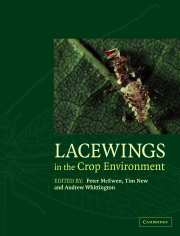Book contents
- Frontmatter
- Contents
- List of contributors
- Preface
- PART 1 Lacewing systematics and ecology
- CHAPTER 1 Introduction to the Neuroptera: what are they and how do they operate?
- CHAPTER 2 Introduction to the systematics and distribution of Coniopterygidae, Hemerobiidae, and Chrysopidae used in pest management
- CHAPTER 3 The common green lacewing (Chrysoperla carnea s. lat.) and the sibling species problem
- CHAPTER 4 Recognition of larval Neuroptera
- CHAPTER 5 Ecology and habitat relationships
- CHAPTER 6 Natural food and feeding habits of lacewings
- CHAPTER 7 Outlines of lacewing development
- PART 2 Lacewings in crops
- PART 3 Principles
- PART 4 Case studies
- PART 5 Conclusion
- Taxonomic index
- General index
CHAPTER 5 - Ecology and habitat relationships
Published online by Cambridge University Press: 04 May 2010
- Frontmatter
- Contents
- List of contributors
- Preface
- PART 1 Lacewing systematics and ecology
- CHAPTER 1 Introduction to the Neuroptera: what are they and how do they operate?
- CHAPTER 2 Introduction to the systematics and distribution of Coniopterygidae, Hemerobiidae, and Chrysopidae used in pest management
- CHAPTER 3 The common green lacewing (Chrysoperla carnea s. lat.) and the sibling species problem
- CHAPTER 4 Recognition of larval Neuroptera
- CHAPTER 5 Ecology and habitat relationships
- CHAPTER 6 Natural food and feeding habits of lacewings
- CHAPTER 7 Outlines of lacewing development
- PART 2 Lacewings in crops
- PART 3 Principles
- PART 4 Case studies
- PART 5 Conclusion
- Taxonomic index
- General index
Summary
INTRODUCTION
During the 15 years since the publication of the last comprehensive book on lacewings (Canard et al., 1984), some excellent reviews have been published on the ecology of lacewings (New, 1986, 1989; Bay et al., 1993). Certain chapters of the present book cover ecological issues (such as food selection and utilisation, life-cycle characteristics, diapause, assessment of the impact of lacewings, natural enemies of lacewings, biodiversity conservation, enhancing chrysopids in field crops) and for this reason this chapter mainly focuses on issues relating to field ecology, in particular on lacewing patterns that are characteristic of different temporal and spatial scale levels, organisation of lacewing guilds, and chemical relationships between lacewings and the environment (chemical ecology).
The study of various spatial and temporal scale levels has great importance (Wiens et al., 1986) in ecological issues. Knowledge of the dynamic processes of differing scale levels may be used in conservation of natural enemies and enhancement of their impact in agricultural or forest habitats.
TEMPORAL PATTERNS OF LACEWINGS
Long-term fluctuation patterns and population dynamics
Few studies have been carried out on year-to-year population changes of lacewings. In order to recognise real population dynamics, changes in the abundance of species and environmental factors should be observed over numerous generations in the same localities.
Ressl (1971) and Gepp (1973) published long-term data on individual numbers of chrysopids without any evaluation. Over ten (1961–1970) and nine (1964–1972) years' study in Austria, Ressl and Gepp respectively reported the yearly numbers of lacewings.
- Type
- Chapter
- Information
- Lacewings in the Crop Environment , pp. 82 - 115Publisher: Cambridge University PressPrint publication year: 2001
- 17
- Cited by



